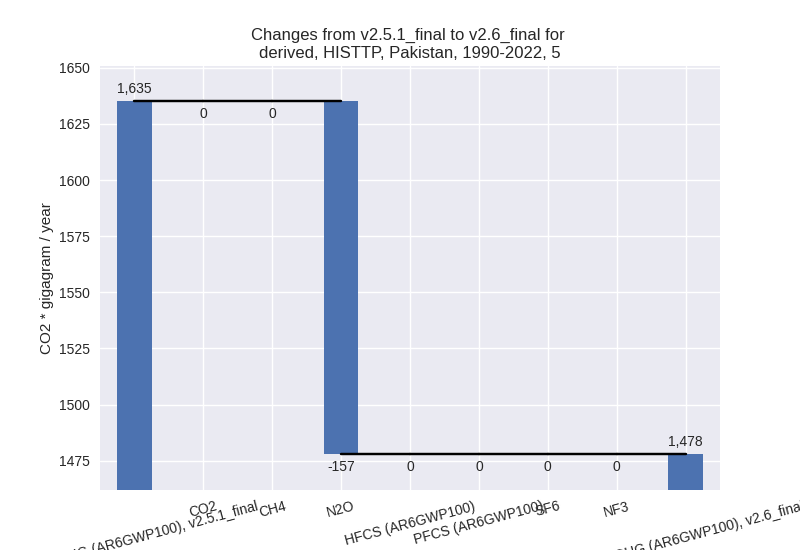Changes in PRIMAP-hist v2.6_final compared to v2.5.1_final for Pakistan
2024-09-24
Johannes Gütschow
Change analysis for Pakistan for PRIMAP-hist v2.6_final compared to v2.5.1_final
Overview over emissions by sector and gas
The following figures show the aggregate national total emissions excluding LULUCF AR6GWP100 for the country reported priority scenario. The dotted linesshow the v2.5.1_final data.
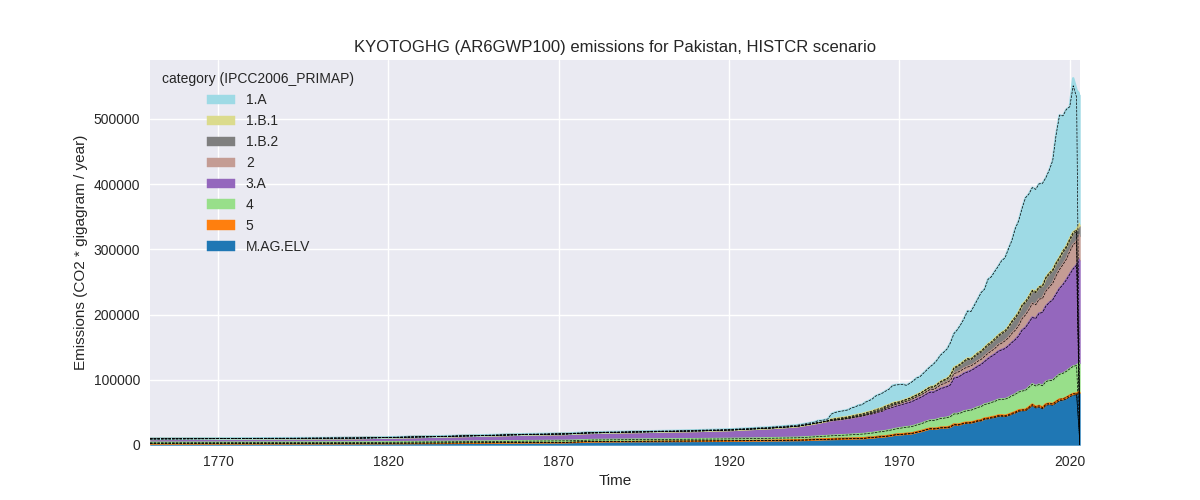

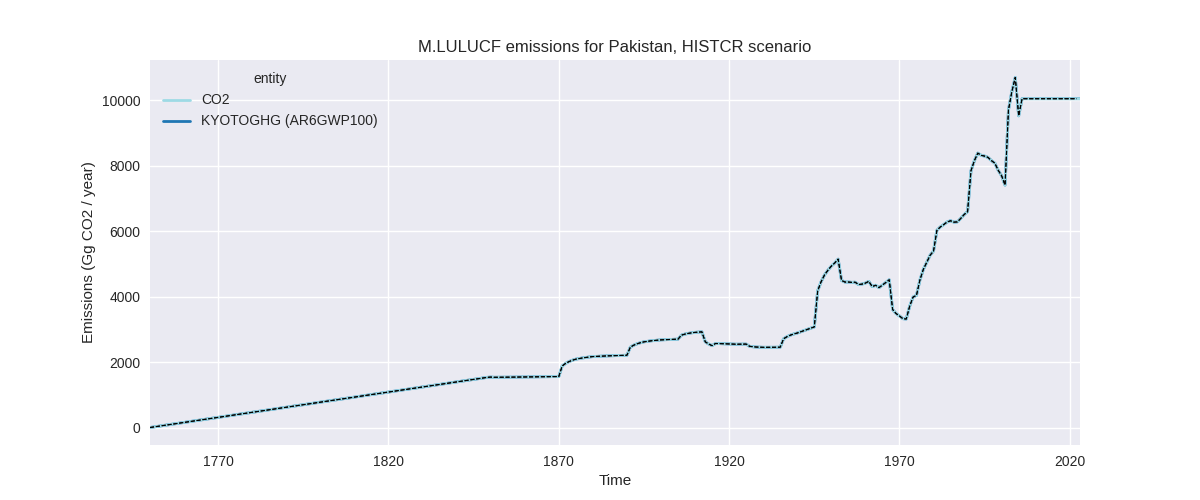
The following figures show the aggregate national total emissions excluding LULUCF AR6GWP100 for the third party priority scenario. The dotted linesshow the v2.5.1_final data.
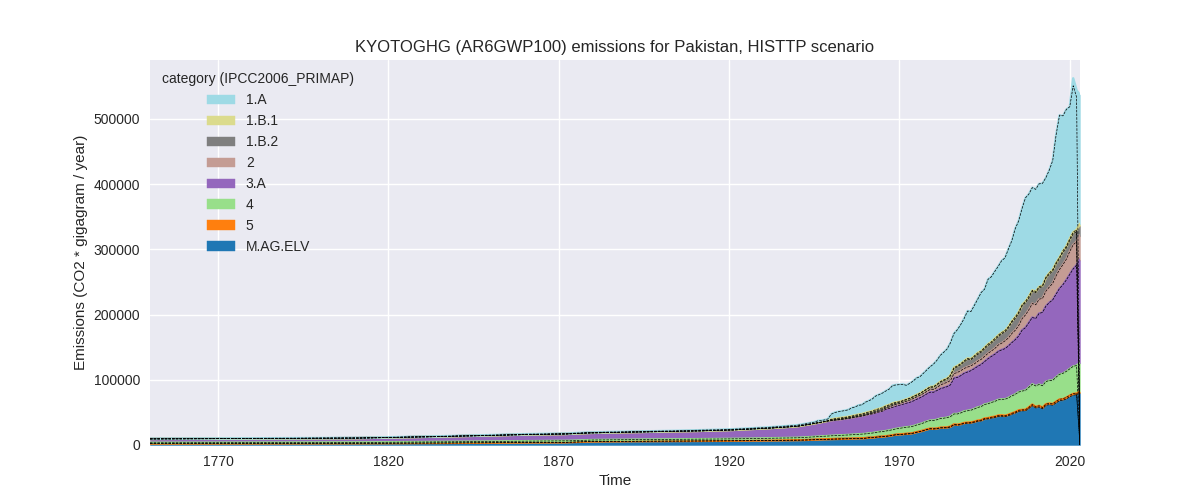
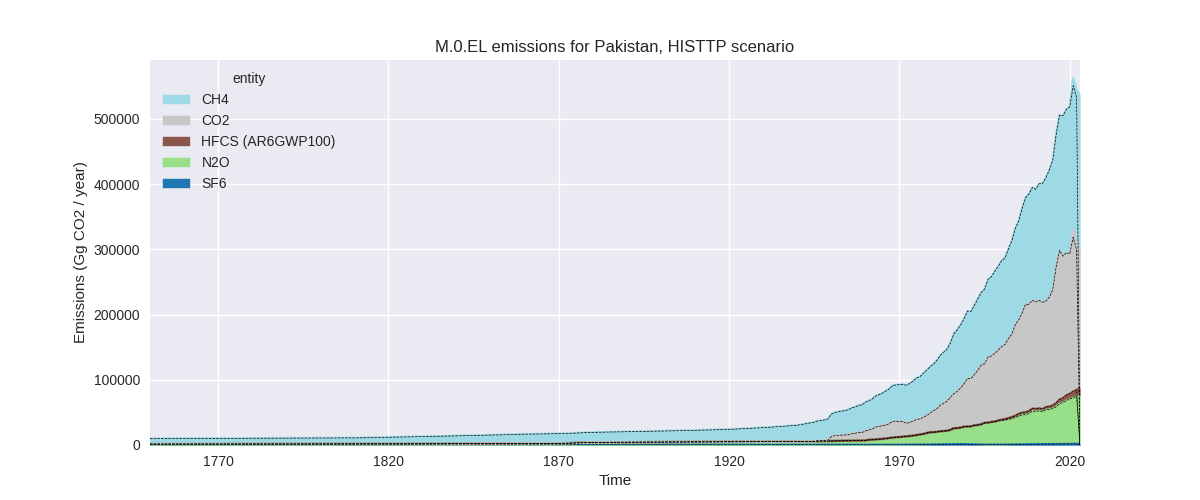
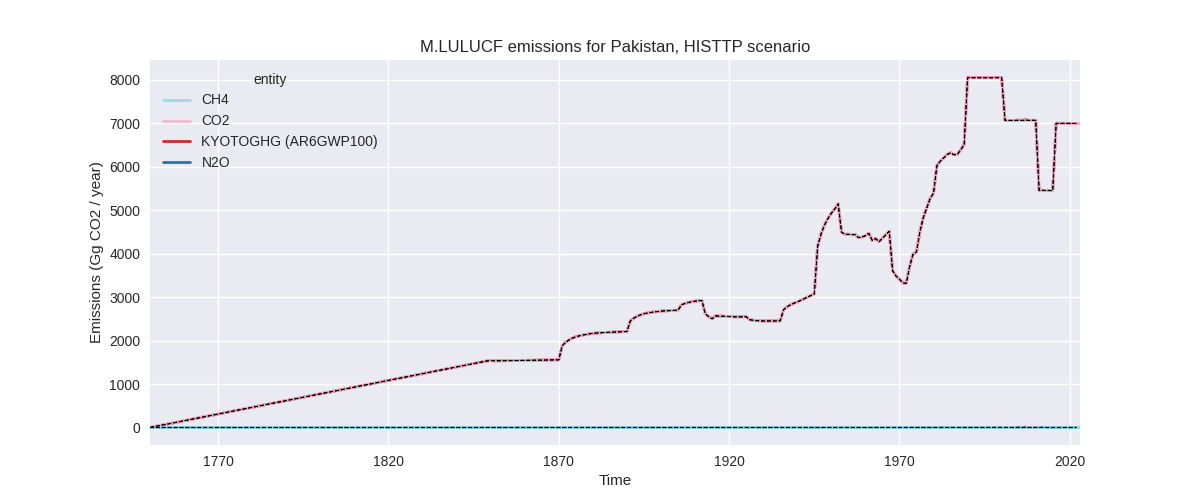
Overview over changes
In the country reported priority scenario we have the following changes for aggregate Kyoto GHG and national total emissions excluding LULUCF (M.0.EL):
- Emissions in 2022 have changed by 2.0%% (10507.60 Gg CO2 / year)
- Emissions in 1990-2022 have changed by 0.2%% (575.69 Gg CO2 / year)
In the third party priority scenario we have the following changes for aggregate Kyoto GHG and national total emissions excluding LULUCF (M.0.EL):
- Emissions in 2022 have changed by 2.0%% (10507.60 Gg CO2 / year)
- Emissions in 1990-2022 have changed by 0.2%% (575.69 Gg CO2 / year)
Most important changes per scenario and time frame
In the country reported priority scenario the following sector-gas combinations have the highest absolute impact on national total KyotoGHG (AR6GWP100) emissions in 2022 (top 5):
- 1: 1.A, CO2 with 10532.32 Gg CO2 / year (5.7%)
- 2: 5, N2O with -601.46 Gg CO2 / year (-24.9%)
- 3: 4, CH4 with 372.52 Gg CO2 / year (0.9%)
- 4: 2, HFCS (AR6GWP100) with 147.97 Gg CO2 / year (1.5%)
- 5: 1.B.2, CO2 with -41.51 Gg CO2 / year (-6.9%)
In the country reported priority scenario the following sector-gas combinations have the highest absolute impact on national total KyotoGHG (AR6GWP100) emissions in 1990-2022 (top 5):
- 1: 1.A, CO2 with 670.16 Gg CO2 / year (0.5%)
- 2: 5, N2O with -157.17 Gg CO2 / year (-9.6%)
- 3: 4, CH4 with 22.94 Gg CO2 / year (0.1%)
- 4: 2, HFCS (AR6GWP100) with 4.48 Gg CO2 / year (0.1%)
- 5: 1.B.2, CO2 with 1.28 Gg CO2 / year (0.5%)
In the third party priority scenario the following sector-gas combinations have the highest absolute impact on national total KyotoGHG (AR6GWP100) emissions in 2022 (top 5):
- 1: 1.A, CO2 with 10532.32 Gg CO2 / year (5.7%)
- 2: 5, N2O with -601.46 Gg CO2 / year (-24.9%)
- 3: 4, CH4 with 372.52 Gg CO2 / year (0.9%)
- 4: 2, HFCS (AR6GWP100) with 147.97 Gg CO2 / year (1.5%)
- 5: 1.B.2, CO2 with -41.51 Gg CO2 / year (-6.9%)
In the third party priority scenario the following sector-gas combinations have the highest absolute impact on national total KyotoGHG (AR6GWP100) emissions in 1990-2022 (top 5):
- 1: 1.A, CO2 with 670.16 Gg CO2 / year (0.5%)
- 2: 5, N2O with -157.17 Gg CO2 / year (-9.6%)
- 3: 4, CH4 with 22.94 Gg CO2 / year (0.1%)
- 4: 2, HFCS (AR6GWP100) with 4.48 Gg CO2 / year (0.1%)
- 5: 1.B.2, CO2 with 1.28 Gg CO2 / year (0.5%)
Notes on data changes
Here we list notes explaining important emissions changes for the country. ’' means that the following text only applies to the TP time series, while means that it only applies to the CR scenario. Otherwise the note applies to both scenarios.
- We have no included new country reported data for Pakistan.
- Changes in energy and flaring CO2 are due to updated third party data.
- Changes in TP and CR time series are very similar.
Changes by sector and gas
For each scenario and time frame the changes are displayed for all individual sectors and all individual gases. In the sector plot we use aggregate Kyoto GHGs in AR6GWP100. In the gas plot we usenational total emissions without LULUCF. ## country reported scenario
2022
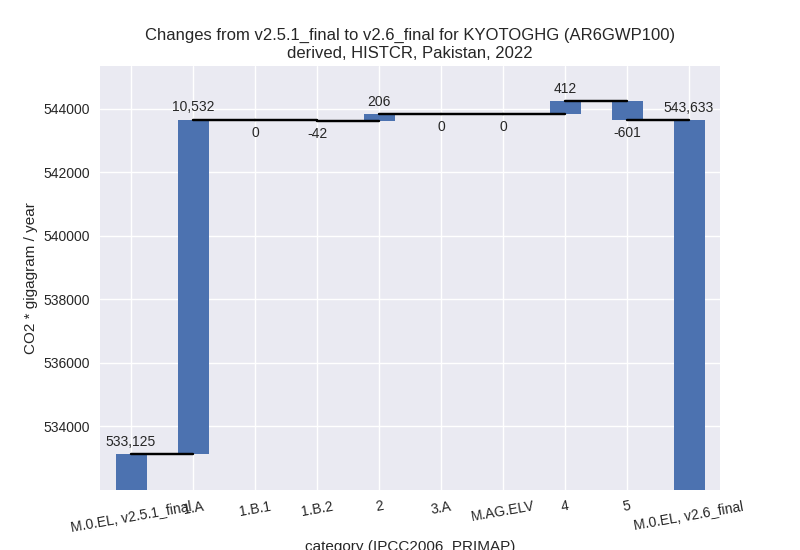
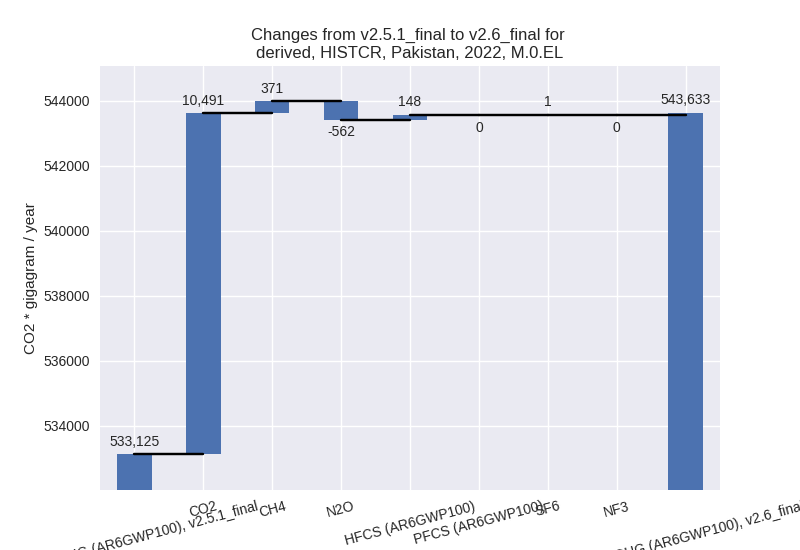
1990-2022
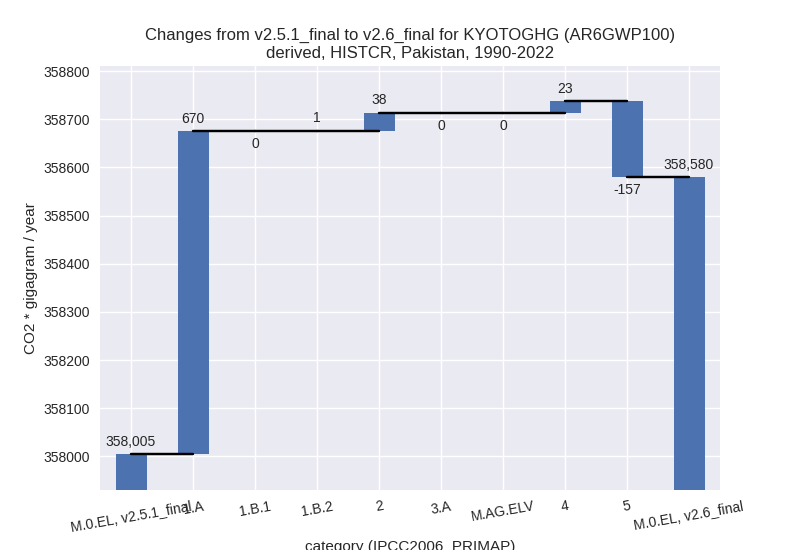
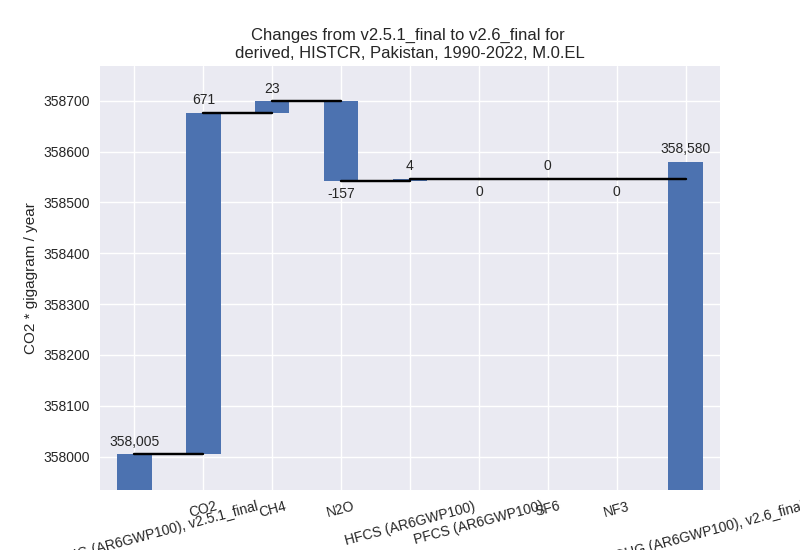
third party scenario
2022
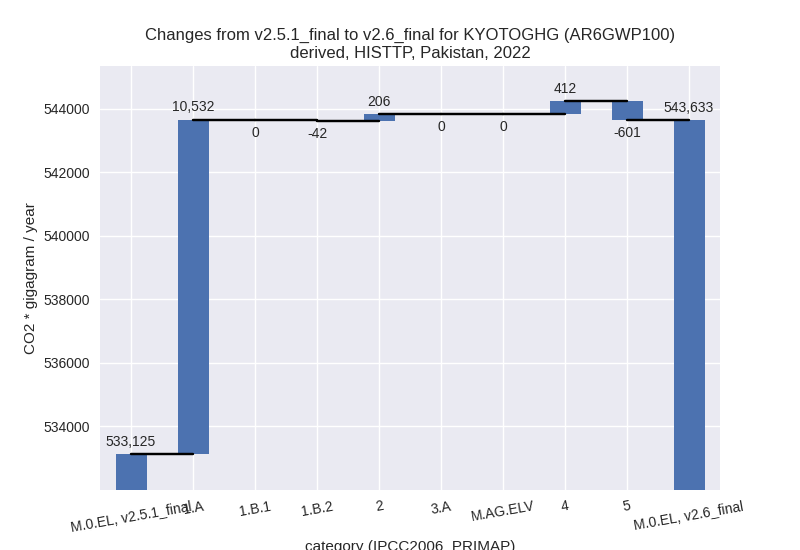
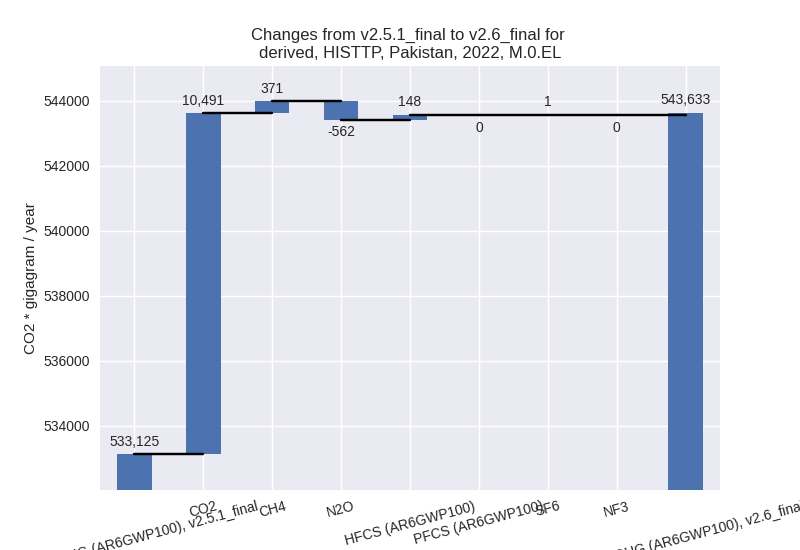
1990-2022
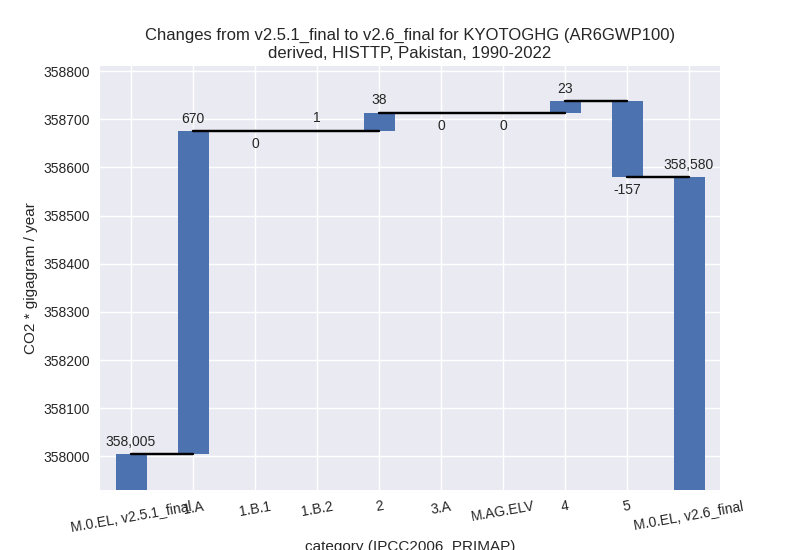
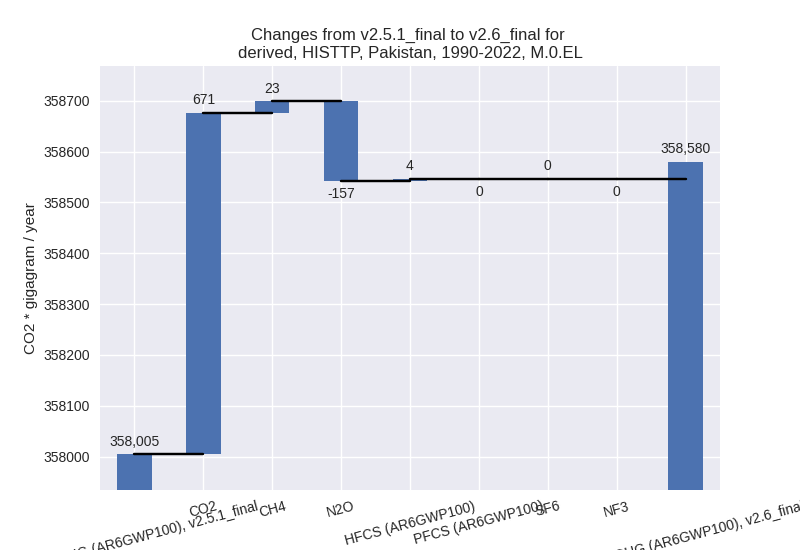
Detailed changes for the scenarios:
country reported scenario (HISTCR):
Most important changes per time frame
For 2022 the following sector-gas combinations have the highest absolute impact on national total KyotoGHG (AR6GWP100) emissions in 2022 (top 5):
- 1: 1.A, CO2 with 10532.32 Gg CO2 / year (5.7%)
- 2: 5, N2O with -601.46 Gg CO2 / year (-24.9%)
- 3: 4, CH4 with 372.52 Gg CO2 / year (0.9%)
- 4: 2, HFCS (AR6GWP100) with 147.97 Gg CO2 / year (1.5%)
- 5: 1.B.2, CO2 with -41.51 Gg CO2 / year (-6.9%)
For 1990-2022 the following sector-gas combinations have the highest absolute impact on national total KyotoGHG (AR6GWP100) emissions in 1990-2022 (top 5):
- 1: 1.A, CO2 with 670.16 Gg CO2 / year (0.5%)
- 2: 5, N2O with -157.17 Gg CO2 / year (-9.6%)
- 3: 4, CH4 with 22.94 Gg CO2 / year (0.1%)
- 4: 2, HFCS (AR6GWP100) with 4.48 Gg CO2 / year (0.1%)
- 5: 1.B.2, CO2 with 1.28 Gg CO2 / year (0.5%)
Changes in the main sectors for aggregate KyotoGHG (AR6GWP100) are
- 1: Total sectoral emissions in 2022 are 231917.58
Gg CO2 / year which is 42.7% of M.0.EL emissions. 2022 Emissions have
changed by 4.7% (10490.81 Gg CO2 /
year). 1990-2022 Emissions have changed by 0.4% (671.44 Gg CO2 / year). For 2022 the
changes per gas
are:
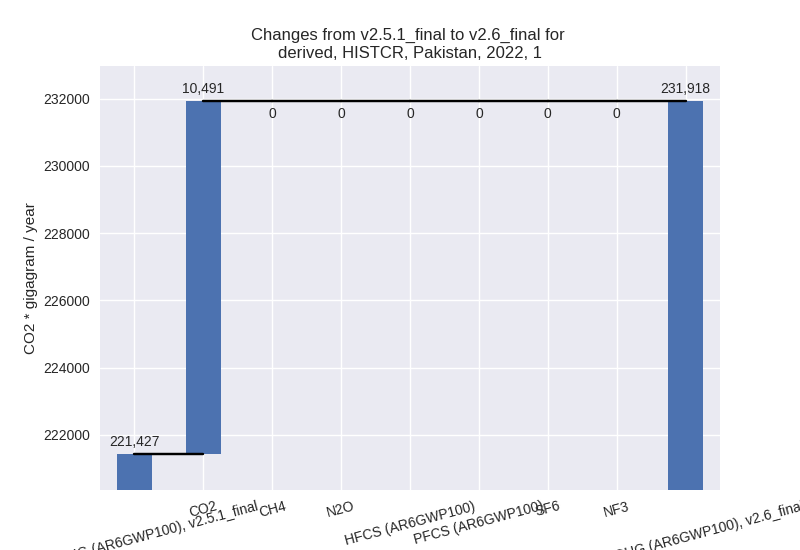
The changes come from the following subsectors:- 1.A: Total sectoral emissions in 2022 are 213828.93
Gg CO2 / year which is 92.2% of category 1 emissions. 2022 Emissions
have changed by 5.2% (10532.32 Gg
CO2 / year). 1990-2022 Emissions have changed by 0.5% (670.16 Gg CO2 / year). For 2022 the
changes per gas
are:
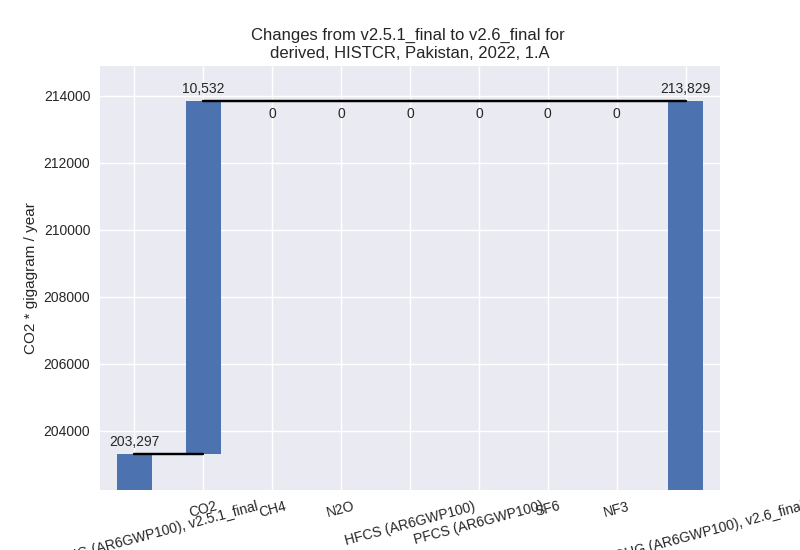
There is no subsector information available in PRIMAP-hist. - 1.B.1: Total sectoral emissions in 2022 are 2529.47 Gg CO2 / year which is 1.1% of category 1 emissions. 2022 Emissions have changed by 0.0% (0.00 Gg CO2 / year). 1990-2022 Emissions have changed by 0.0% (0.00 Gg CO2 / year).
- 1.B.2: Total sectoral emissions in 2022 are 15559.18 Gg CO2 / year which is 6.7% of category 1 emissions. 2022 Emissions have changed by -0.3% (-41.51 Gg CO2 / year). 1990-2022 Emissions have changed by 0.0% (1.28 Gg CO2 / year).
- 1.A: Total sectoral emissions in 2022 are 213828.93
Gg CO2 / year which is 92.2% of category 1 emissions. 2022 Emissions
have changed by 5.2% (10532.32 Gg
CO2 / year). 1990-2022 Emissions have changed by 0.5% (670.16 Gg CO2 / year). For 2022 the
changes per gas
are:
- 2: Total sectoral emissions in 2022 are 36195.09 Gg CO2 / year which is 6.7% of M.0.EL emissions. 2022 Emissions have changed by 0.6% (206.24 Gg CO2 / year). 1990-2022 Emissions have changed by 0.2% (38.01 Gg CO2 / year).
- M.AG: Total sectoral emissions in 2022 are 230934.42 Gg CO2 / year which is 42.5% of M.0.EL emissions. 2022 Emissions have changed by 0.0% (0.00 Gg CO2 / year). 1990-2022 Emissions have changed by 0.0% (0.00 Gg CO2 / year).
- 4: Total sectoral emissions in 2022 are 42771.34 Gg CO2 / year which is 7.9% of M.0.EL emissions. 2022 Emissions have changed by 1.0% (412.01 Gg CO2 / year). 1990-2022 Emissions have changed by 0.1% (23.41 Gg CO2 / year).
- 5: Total sectoral emissions in 2022 are 1814.56 Gg
CO2 / year which is 0.3% of M.0.EL emissions. 2022 Emissions have
changed by -24.9% (-601.46 Gg CO2 /
year). 1990-2022 Emissions have changed by -9.6% (-157.17 Gg CO2 / year). For 2022
the changes per gas
are:

For 1990-2022 the changes per gas are: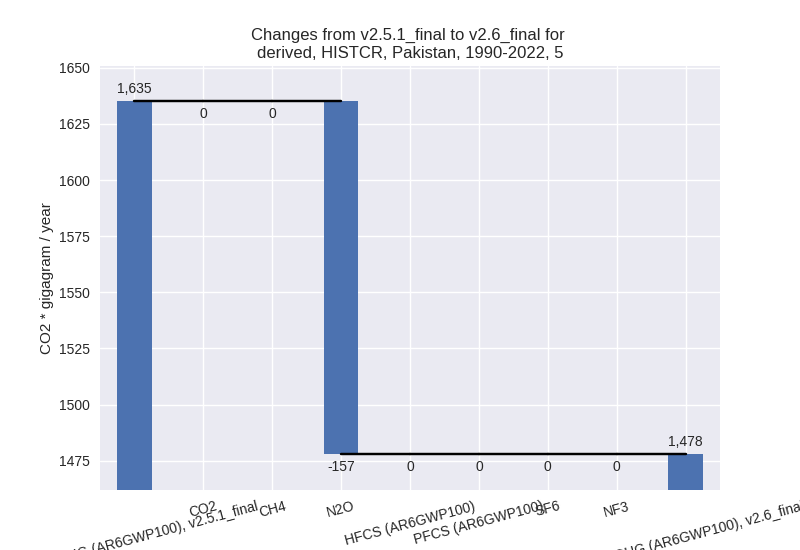
third party scenario (HISTTP):
Most important changes per time frame
For 2022 the following sector-gas combinations have the highest absolute impact on national total KyotoGHG (AR6GWP100) emissions in 2022 (top 5):
- 1: 1.A, CO2 with 10532.32 Gg CO2 / year (5.7%)
- 2: 5, N2O with -601.46 Gg CO2 / year (-24.9%)
- 3: 4, CH4 with 372.52 Gg CO2 / year (0.9%)
- 4: 2, HFCS (AR6GWP100) with 147.97 Gg CO2 / year (1.5%)
- 5: 1.B.2, CO2 with -41.51 Gg CO2 / year (-6.9%)
For 1990-2022 the following sector-gas combinations have the highest absolute impact on national total KyotoGHG (AR6GWP100) emissions in 1990-2022 (top 5):
- 1: 1.A, CO2 with 670.16 Gg CO2 / year (0.5%)
- 2: 5, N2O with -157.17 Gg CO2 / year (-9.6%)
- 3: 4, CH4 with 22.94 Gg CO2 / year (0.1%)
- 4: 2, HFCS (AR6GWP100) with 4.48 Gg CO2 / year (0.1%)
- 5: 1.B.2, CO2 with 1.28 Gg CO2 / year (0.5%)
Changes in the main sectors for aggregate KyotoGHG (AR6GWP100) are
- 1: Total sectoral emissions in 2022 are 231917.58
Gg CO2 / year which is 42.7% of M.0.EL emissions. 2022 Emissions have
changed by 4.7% (10490.81 Gg CO2 /
year). 1990-2022 Emissions have changed by 0.4% (671.44 Gg CO2 / year). For 2022 the
changes per gas
are:
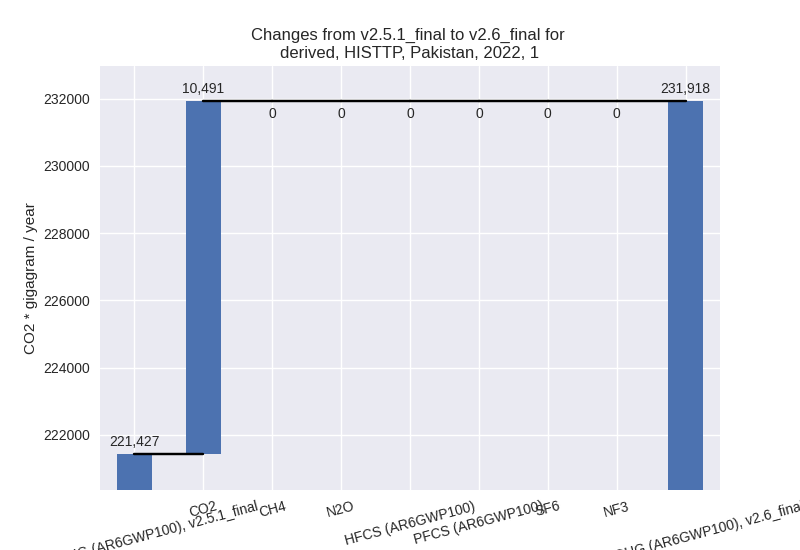
The changes come from the following subsectors:- 1.A: Total sectoral emissions in 2022 are 213828.93
Gg CO2 / year which is 92.2% of category 1 emissions. 2022 Emissions
have changed by 5.2% (10532.32 Gg
CO2 / year). 1990-2022 Emissions have changed by 0.5% (670.16 Gg CO2 / year). For 2022 the
changes per gas
are:
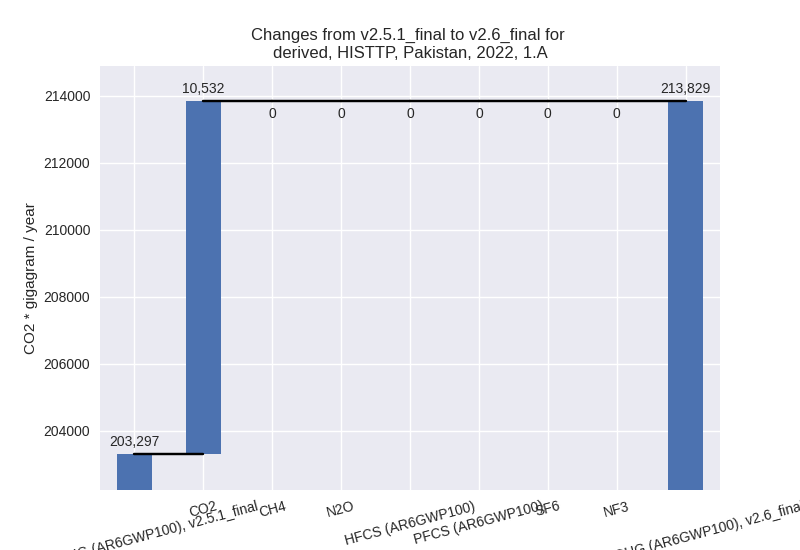
There is no subsector information available in PRIMAP-hist. - 1.B.1: Total sectoral emissions in 2022 are 2529.47 Gg CO2 / year which is 1.1% of category 1 emissions. 2022 Emissions have changed by 0.0% (0.00 Gg CO2 / year). 1990-2022 Emissions have changed by 0.0% (0.00 Gg CO2 / year).
- 1.B.2: Total sectoral emissions in 2022 are 15559.18 Gg CO2 / year which is 6.7% of category 1 emissions. 2022 Emissions have changed by -0.3% (-41.51 Gg CO2 / year). 1990-2022 Emissions have changed by 0.0% (1.28 Gg CO2 / year).
- 1.A: Total sectoral emissions in 2022 are 213828.93
Gg CO2 / year which is 92.2% of category 1 emissions. 2022 Emissions
have changed by 5.2% (10532.32 Gg
CO2 / year). 1990-2022 Emissions have changed by 0.5% (670.16 Gg CO2 / year). For 2022 the
changes per gas
are:
- 2: Total sectoral emissions in 2022 are 36195.09 Gg CO2 / year which is 6.7% of M.0.EL emissions. 2022 Emissions have changed by 0.6% (206.24 Gg CO2 / year). 1990-2022 Emissions have changed by 0.2% (38.01 Gg CO2 / year).
- M.AG: Total sectoral emissions in 2022 are 230934.42 Gg CO2 / year which is 42.5% of M.0.EL emissions. 2022 Emissions have changed by 0.0% (0.00 Gg CO2 / year). 1990-2022 Emissions have changed by 0.0% (0.00 Gg CO2 / year).
- 4: Total sectoral emissions in 2022 are 42771.34 Gg CO2 / year which is 7.9% of M.0.EL emissions. 2022 Emissions have changed by 1.0% (412.01 Gg CO2 / year). 1990-2022 Emissions have changed by 0.1% (23.41 Gg CO2 / year).
- 5: Total sectoral emissions in 2022 are 1814.56 Gg
CO2 / year which is 0.3% of M.0.EL emissions. 2022 Emissions have
changed by -24.9% (-601.46 Gg CO2 /
year). 1990-2022 Emissions have changed by -9.6% (-157.17 Gg CO2 / year). For 2022
the changes per gas
are:
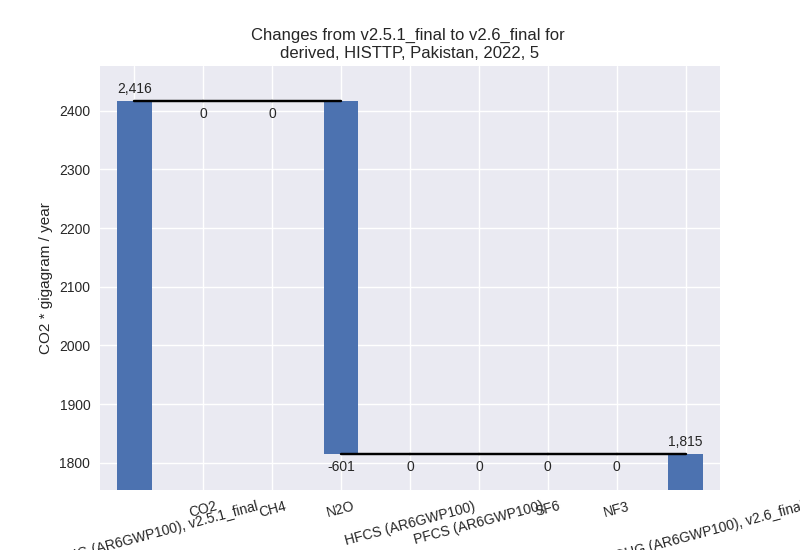
For 1990-2022 the changes per gas are: